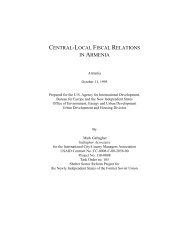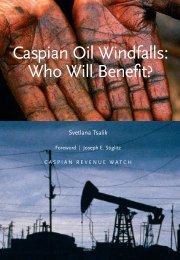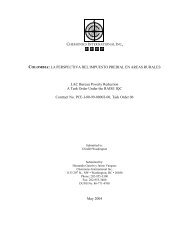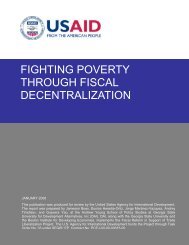Effectiveness and Economic Impact of Tax Incentives in the SADC ...
Effectiveness and Economic Impact of Tax Incentives in the SADC ...
Effectiveness and Economic Impact of Tax Incentives in the SADC ...
You also want an ePaper? Increase the reach of your titles
YUMPU automatically turns print PDFs into web optimized ePapers that Google loves.
2-8 EFFECTIVENESS AND IMPACT OF TAX INCENTIVES IN THE <strong>SADC</strong> REGION<br />
actual impact. (Still, policy changes that worsen pr<strong>of</strong>itability may provoke an immediate<br />
cessation <strong>of</strong> planned <strong>in</strong>vestments.)<br />
Second, recent models that highlight <strong>the</strong> effect <strong>of</strong> uncerta<strong>in</strong>ty show that <strong>in</strong>vestors may defer<br />
projects even if <strong>the</strong>y are fundamentally viable. Faced with substantial uncerta<strong>in</strong>ty about<br />
economic stability or <strong>the</strong> susta<strong>in</strong>ability <strong>of</strong> pro-<strong>in</strong>vestment policies, along with irreversible<br />
start-up costs, <strong>in</strong>vestors may choose to wait <strong>and</strong> see how events unfold before committ<strong>in</strong>g<br />
funds. Implicitly, <strong>the</strong>y dem<strong>and</strong> a higher hurdle rate consist<strong>in</strong>g <strong>of</strong> <strong>the</strong> st<strong>and</strong>ard UCC plus <strong>the</strong><br />
value <strong>of</strong> <strong>the</strong> “option to wait.” 17 The result may be a very sluggish <strong>in</strong>vestment response. The<br />
antidote is to reduce uncerta<strong>in</strong>ty by establish<strong>in</strong>g a track record <strong>of</strong> dependable policy<br />
management <strong>and</strong> political stability.<br />
Third, liquidity constra<strong>in</strong>ts <strong>and</strong> imperfections <strong>in</strong> <strong>the</strong> f<strong>in</strong>ancial markets can enhance <strong>the</strong><br />
effectiveness <strong>of</strong> tax cuts. The neoclassical model assumes that <strong>in</strong>vestors have access to debt<br />
<strong>and</strong> equity f<strong>in</strong>anc<strong>in</strong>g at a market-determ<strong>in</strong>ed cost <strong>of</strong> funds (adjusted for risk). This is a<br />
reasonable assumption for large mult<strong>in</strong>ational companies. But for many companies <strong>the</strong> ma<strong>in</strong><br />
source <strong>of</strong> funds for <strong>in</strong>vestment is reta<strong>in</strong>ed earn<strong>in</strong>gs. In this case, tax cuts can foster <strong>in</strong>vestment<br />
by augment<strong>in</strong>g <strong>the</strong> company’s net cash flow, provid<strong>in</strong>g <strong>the</strong> means to take advantage <strong>of</strong> viable<br />
<strong>in</strong>vestment opportunities that o<strong>the</strong>rwise would be missed for lack <strong>of</strong> f<strong>in</strong>ance.<br />
ROLE OF INDIRECT TAXES<br />
How do <strong>in</strong>direct taxes such as import duties <strong>and</strong> VAT enter <strong>the</strong> <strong>the</strong>oretical analysis <strong>of</strong> <strong>the</strong><br />
<strong>in</strong>vestment decision? The usual premise is that a uniform tax on production or sales does not<br />
substantially affect <strong>in</strong>vestment <strong>in</strong>centives because it is largely passed along to f<strong>in</strong>al consumers<br />
<strong>in</strong> <strong>the</strong> form <strong>of</strong> higher product prices. However, <strong>in</strong>vestment behavior can be strongly<br />
<strong>in</strong>fluenced by differential <strong>in</strong>direct taxes which fall on some activities more than o<strong>the</strong>rs. For<br />
example, <strong>the</strong> common policy <strong>of</strong> impos<strong>in</strong>g lower import duty on <strong>in</strong>puts than on outputs<br />
enhances <strong>the</strong> pr<strong>of</strong>itability <strong>of</strong> import-substitution activities, stimulat<strong>in</strong>g <strong>in</strong>vestment that would<br />
o<strong>the</strong>rwise not be pr<strong>of</strong>itable or susta<strong>in</strong>able. (Chapter 3 discusses <strong>the</strong> economic efficiency cost <strong>of</strong><br />
this <strong>in</strong>vestment promotion policy.)<br />
Ano<strong>the</strong>r important <strong>in</strong>direct tax issue is <strong>the</strong> imposition <strong>of</strong> import duty or tax on <strong>the</strong> purchase<br />
<strong>of</strong> mach<strong>in</strong>ery <strong>and</strong> equipment. If this tax (tK) were fully passed along to consumers, <strong>the</strong>n it<br />
would not significantly affect <strong>the</strong> pr<strong>of</strong>it maximization decision <strong>of</strong> <strong>in</strong>vestors. But it might not<br />
be passed through fully if <strong>the</strong> duty on compet<strong>in</strong>g imports <strong>of</strong> f<strong>in</strong>al products rema<strong>in</strong>s<br />
unchanged, or if compet<strong>in</strong>g producers use more labor-<strong>in</strong>tensive production processes <strong>and</strong><br />
<strong>the</strong>refore pay less <strong>of</strong> this tax. In <strong>the</strong>se cases, competition constra<strong>in</strong>s <strong>the</strong> output price, so <strong>the</strong><br />
producer would bear <strong>the</strong> cost <strong>of</strong> <strong>the</strong> <strong>in</strong>direct tax. The price <strong>of</strong> capital goods <strong>in</strong> <strong>the</strong> model rises<br />
from PK to (1 + tK) PK. By <strong>in</strong>creas<strong>in</strong>g <strong>the</strong> price <strong>of</strong> capital goods, <strong>the</strong> <strong>in</strong>direct tax on mach<strong>in</strong>ery<br />
17 See Hubbard (1994) for an excellent review <strong>of</strong> <strong>the</strong>se “real option” models.











